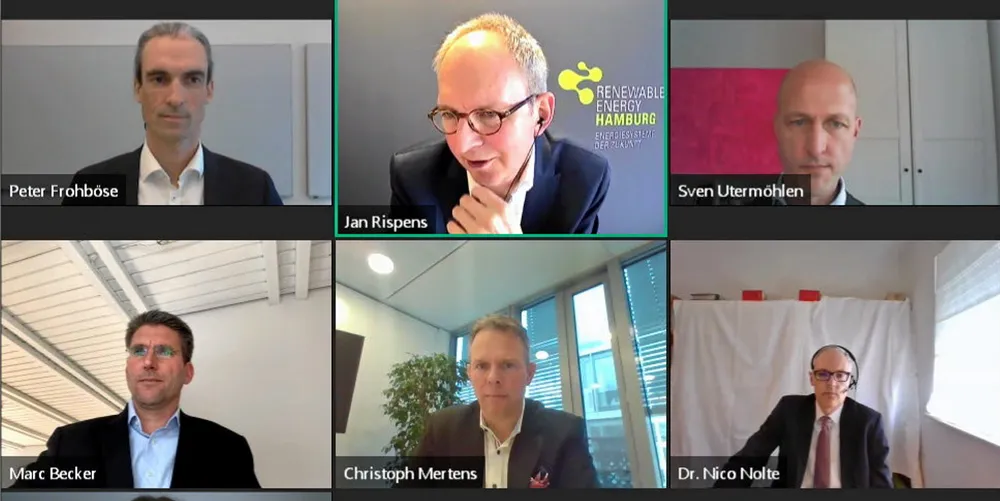End 'Kindergarten' politics or offshore wind market will move elsewhere, Berlin told
Sumitomo, RWE and Siemens Gamesa lament frequently changing rules and targets, as well as legal uncertainties, for wind at sea in Germany

Incoherent and frequently changing rules and targets, as well as a dissatisfying support regime for offshore wind harm the otherwise successful sector in Germany, and could prompt major players to increasingly seek their luck in other markets, industry heavyweights warned at the Hamburg Offshore Wind Conference 2021.
Germany in recent years had at first lowered its ambition for wind at sea, and then raised it again, to 20GW in 2030 and 40GW in 2040. But it is yet unclear, how quickly the country’s maritime and hydrographic agency (BSH) can find the additional sea space for all of the capacity.
A change from a fixed feed-in tariff (FIT) system to one in which the level of support is determined in competitive tenders also was problematic for the sector as the government had to find an interim auction regime for several gigawatts of pre-developed projects that inadvertently led to the world’s first zero-subsidy outcomes.
“The lack of continuity in the German market is and will remain a long-lasting problem. Especially having experienced a drop in FITs from €190/MWh to zero within 10 years only,” Christoph Mertens, chief executive of Sumitomo’s European unit Summit Renewable Power told the online conference.
German regulation at first showed strengths, through a maritime spatial planning introduced by the BSH already in 2009, a robust consenting process and an initially very strong support regime, Mertens said. But he criticised that Berlin refuses to introduce contracts for difference (CfDs) - that have been successful in the UK and other European markets -, and exposed the sector to a constantly changing regulatory framework and inconsistent new annual capacity.
Legal concerns remain in particular over the preemptive ‘legal entry right’ some companies are granted in upcoming regular tenders, Mertens stressed.
The rule was introduced as a compensation for companies that had incurred dozens of millions of euros in development costs for an area, but still didn't win with that project in the 2017 or 2018 auctions for pre-developed zones – among them are Iberdrola and Northland Power.
If the companies befitting from the rule go ahead and exercise their legal entry right at this year’s German offshore wind auction, they could snap away the areas from whoever would have won the tender otherwise, just by matching the winning bid.
“That reminds me a bit of Kindergarten, when two kids want to play with same toy,” Mertens said.
Sumitomo, which already owns stakes in offshore wind projects in the UK, France and Belgium, doesn’t have any projects in Germany, although its European unit is headquartered in Düsseldorf. The company sees 19GW of investment opportunities in Europe – in countries ranging from Poland to Ireland – but didn’t consider Germany as attractive enough to include it in its list of potential offshore wind investments.
But also big German players are increasingly frustrated with Berlin’s erratic offshore wind policy.
RWE, one of the world’s top operators and developers of offshore wind, shares several of Sumitomo’s worries.
“It is important that there is a more or less stable outlook of auctions taking place and, of course, there is a concern that we still don’t have a CfD system,” Sven Utermöhlen, chief operating officer of RWE Renewable’s offshore wind unit, told a panel at the Hamburg conference.
“And there is a concern that there could be further changes required to the regulatory system. That is always a difficult situation, because it usually slows down the auction pace and that is not good for the businesses.”
RWE wants to grow further in offshore wind, but will do so where conditions are the most attractive, Utermöhlen said, adding that it is not automatically given that Germany’s targeted offshore wind growth will materialise unless conditions are sufficiently attractive.
“There is a global competition for offshore wind growth. There are other markets or countries that also want to grow in offshore wind and they want to attract the investment,” he warned.
Both Utermöhlen, and the CEO of Siemens Gamesa’s offshore segment, Marc Becker, were shocked to hear at the same conference from BSH sea department head Nico Nolte that the agency currently is struggling to find sufficient space in German waters for the 20GW target by 2030.
Nolte said he doesn’t see any additional room for further projects, for example to host offshore wind farms only dedicated to the production of green hydrogen, pointing to ‘problematic’ processes to achieve approval, permits for areas, converter platforms and grid links.
Reacting to Nolte, Becker said he is “really, really puzzled” that after a good start into offshore wind in Germany, there is currently only a focus on problems instead of solutions.
Siemens Gamesa, the world’s top seller of offshore wind turbines, has built a mega offshore wind factory at the German North Sea port town of Cuxhaven, which currently is only churning out machines for the global, but not for the German market, Becker stressed.
“I have more capacity in the factory that we have built in Cuxhaven,” Becker said. But “if the opportunity doesn’t pop up in Germany, then we take it somewhere else.”
Becker also said that a top focus must be to expand Germany’s power grid to be able to transport an increasing volume of offshore wind power from its coasts to the North to consumption centres further South in the country.
(Copyright)